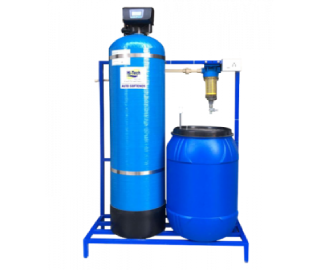Strong, Long Lasting Aquamech WATER SOFTENER- engineered for the most demanding industrial, commercial and residential needs.
Base Exchange Softening Process
In these days Softening of Water is almost exclusively effected by lon Exchanges. In this process the calcium and magnesium ions are exchanger by sodium ions, so that the hardness forming components are converted into soluble sodium salts. Softening is carried out by simple filtration through the exchange material.
When the exchange material is exhausted, it requires regeneration with sodium chloride (Common Salt). The calcium and magnesium ions which were taken up before are then, displaced by sodium ions and flow out together with the regeneration water. The capacities between regeneration will, however, vary according to the raw water.Water product will have commercial Zero hardness. These systems have a proven excellence in performance for application like textile, Boiler Heat Exchanger, Laundry etc.
- • Softeners are available in rust and corrosion proof FRP as well as sturdy M.S.Unit.
- • Control Valve: state-of-the-art design and with in - built ejector system, multi port valve for compact design.
- • Unit with Individual valves of Cast Iron are safe for outdoor application.
- • Completely Automatic is also available.
- • Compact Sturdy FRP Softening Unit
Industrial Water Softener Plant
An Industrial Water Softener Plant is an effective way to treat hard water for various industrial processes. Unlike the standard home softener, the system doesn't require electricity and is very efficient. The plant uses a cation resin bed to remove hardness, resulting in softer water. It works by exchanging calcium and magnesium ions with sodium ions. After the hard water passes through the resin, the salts turn up to dissolve them.
The process of industrial water softening involves using negatively charged resins to absorb and bind the metal ions in water. The resins start with univalent hydrogen or potassium ions and exchange these ions with the calcium and magnesium ions in the water. The hardness ion in water replaces the hydrogen ions released by the resin as the water gets harder, the hydrogen ion-exchanged with the resin increases. As the hardness increases, the hardness ion is replaced by calcium and magnesium ion. Eventually, the process removes the water's iron-rich carbonate, sulphate, and hydroxyl ion content.
The industrial water softening process is a multistage process. The water is pumped from the sump to the resin vessel at a pressure of 2 to 3 kg/cm2. The sodium ions replaced the calcium and magnesium ions in the water. The result is softened water with a hardness range of zero to 10 ppm as CaCO 3. As the resins wear out, they need to be replaced. The regeneration process involves brine solution.
Water Softener Plant Uses
Several different applications are possible with a Water Softener Plant. These applications include extending the life of household appliances, pipelines, solar heating systems, and air conditioning units. In addition, softening the water helps reduce the number of hard minerals in the water, which increases its softer qualities.
Water Softening Plant Process:
The heart of a water softener is a mineral tank. It's Filled with small polystyrene beads, also known as resin or zeolite. The beads carry a negative charge. Calcium and magnesium in water both carry positive charges. This means that these minerals will cling to the beads as the hard water passes through the mineral tank. Sodium ions also have positive charges, albeit not as strong as the charge on the calcium and magnesium.
When a very strong brine solution is flushed through a tank that has beads already saturated with calcium and magnesium, the sheer volume of the sodium ions is enough to drive the calcium and magnesium ions off the beads. Water softeners have a separate brine tank that uses common salt to create this brine solution. In normal operation, hard water moves into the mineral tank and the calcium and magnesium ions move to the beads, replacing sodium ions. The sodium ions go into the water. Once the beads are saturated with calcium and magnesium, the unit enters a 3-phase regenerating cycle. First, the backwash phase reverses water flow to flush dirt out of the tank. In the recharge phase, the concentrated sodium-rich salt solution is carried from the brine tank through the mineral tank. The sodium collects on the beads, replacing the calcium and magnesium, which go down the drain. Once this phase is over, the mineral tank is flushed of excess brine and the brine tank is refilled.
APPLICATIONS
- Boiler Feed
- Air Conditioning Plant
- Beverage Production
- Treated Water Quality
- Cooling Tower Make-Up
- Textile Processing
- Hospitals, Hotels, Laundries etc.
- Total hardness: Less than 5 ppm (Commercial Zero)s

